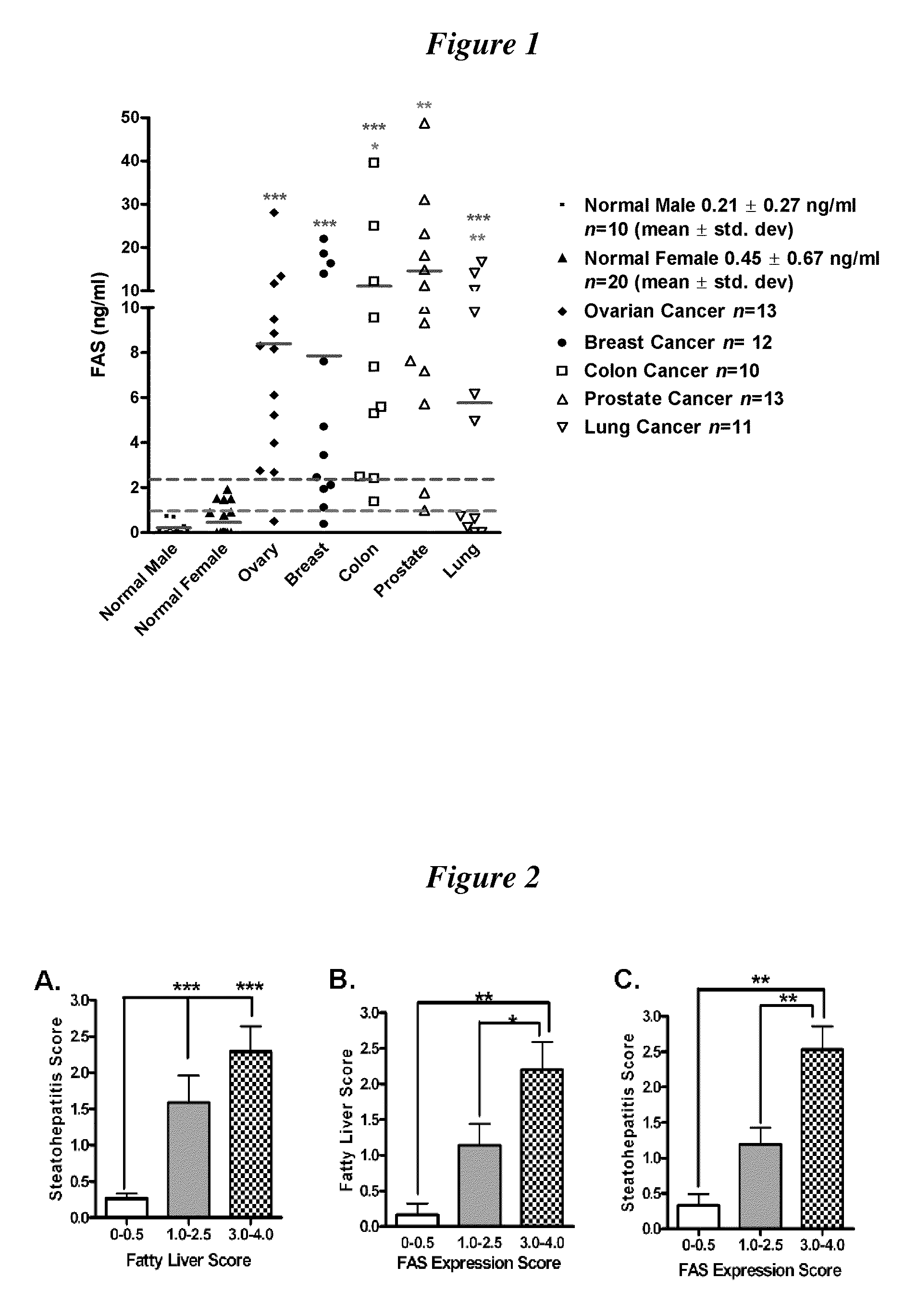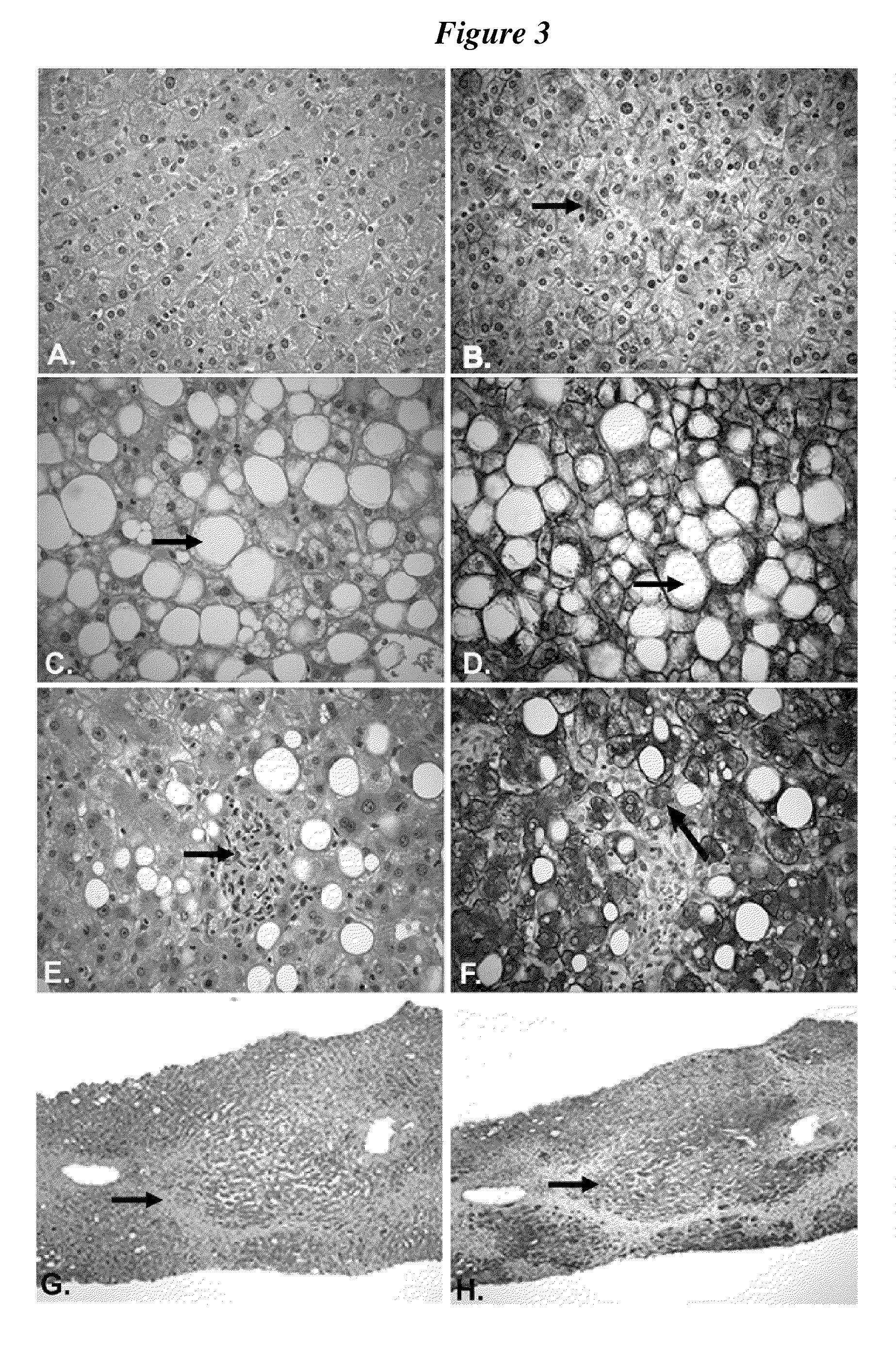Fatty acid synthase in liver disease
- Summary
- Abstract
- Description
- Claims
- Application Information
AI Technical Summary
Benefits of technology
Problems solved by technology
Method used
Image
Examples
example 1
[0090]To examine the relationships among steatosis, steatohepatitis and FAS expression, FAS expression was studied in needle biopsies from 38 obese subjects with immunohistochemistry with a monoclonal anti-human FAS antibody. Steatosis, steatohepatitis, and FAS expression were graded semi-quantitatively from 0-4+ with increments of 0.5. Analysis of the data revealed that steatosis and FAS expression were best grouped into three categories: 0-0.5+ which represented negative or scant expression, 1.0-2.5+ which indicated a mild to moderate expression, and 3.0-4.0 indicating strong expression. FIG. 2 shows the results of this study.
[0091]FIG. 2, Panel A compares the association between steatohepatitis and fatty liver. As expected, patients without fatty liver (0-0.5+) have little steatohepatitis, while those with marked steatosis (3.0-4.0+) have the highest level of steatohepatitis p2).
[0092]FIG. 2, Panel B compares the relationship between fatty liver (steatosis) and FAS expression. Th...
example 2
[0094]FIG. 3 is a series of photomicrographs illustrating the association of FAS expression with steatosis, steatohepatitis, and cirrhosis. FIG. 3A is a hematoxylin and eosin stained section of formalin-fixed paraffin-embedded liver of histologically unremarkable liver without evidence of steatosis or steatohepatitis. In 3B an approximate serial section of the normal liver biopsy was stained with an anti-human FAS mouse monoclonal antibody. There is slight reactivity for FAS in this liver as noted by the brick colored staining which corresponds to FAS expression (arrow). In contrast, FIG. 3C is a hematoxylin and eosin stained section of liver with severe steatosis. The large round spaces which represent triglyeride droplets which engorge the liver cell (arrow) should be noted. This is an example of macrovesicular steatosis. In addition, there are a few cells with small vacuoles which render a ‘soap bubble’ appearance to the cytoplasm indicative of a component of microvesicular steat...
example 3
[0098]To determine the relationship between steatosis or steatohepatitis have detectable circulating FAS, FAS was measured in discarded pre-surgical sera from 16 patients undergoing bariatric surgery for morbid obesity. In addition, surgical liver biopsies were also performed on 12 of these patients to assess the presence of steatosis or steatohepatitis. Serum FAS levels were measured using a monoclonal anti-human FAS sandwich ELISA assay. Compared to 20 normal subjects, the 16 obese patients had higher levels of serum FAS as shown in FIG. 4A (3.5±1.17 ng / ml, obese; 0.17±0.07 ng / ml, normal; p=0.003, two-tailed unpaired t-test, GraphPad Prism version 4.00 for Windows, GraphPad Software, San Diego Calif. USA, www.graphpad.com).
[0099]For the twelve patients, from whom liver tissue was available from surgery, steatohepatitis and steatosis were graded using a 0-4+ semiquantitative scale based on the degree of fatty change, inflammation, and fibrosis. Increased serum FAS levels were assoc...
PUM
 Login to View More
Login to View More Abstract
Description
Claims
Application Information
 Login to View More
Login to View More - R&D
- Intellectual Property
- Life Sciences
- Materials
- Tech Scout
- Unparalleled Data Quality
- Higher Quality Content
- 60% Fewer Hallucinations
Browse by: Latest US Patents, China's latest patents, Technical Efficacy Thesaurus, Application Domain, Technology Topic, Popular Technical Reports.
© 2025 PatSnap. All rights reserved.Legal|Privacy policy|Modern Slavery Act Transparency Statement|Sitemap|About US| Contact US: help@patsnap.com


